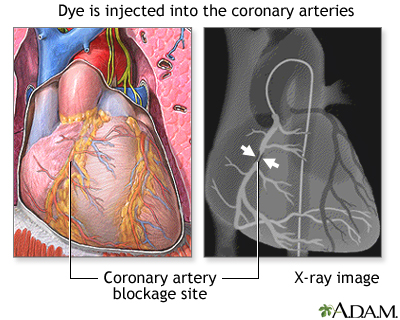- Go to slide 1 out of 9
- Go to slide 2 out of 9
- Go to slide 3 out of 9
- Go to slide 4 out of 9
- Go to slide 5 out of 9
- Go to slide 6 out of 9
- Go to slide 7 out of 9
- Go to slide 8 out of 9
- Go to slide 9 out of 9

Overview
Next, a diagnostic catheter, which is a long narrow tube, is advanced through the introducer over a .035 inch (.0889 cm) guidewire, into the blood vessel. This catheter is then guided to the aorta and the guidewire is removed. Once the catheter is placed in the opening or ostium of one of the coronary arteries, the doctor injects dye and takes a series of X-rays (film of the images).
Review Date 1/1/2025
Updated by: Michael A. Chen, MD, PhD, Associate Professor of Medicine, Division of Cardiology, Harborview Medical Center, University of Washington Medical School, Seattle, WA. Also reviewed by David C. Dugdale, MD, Medical Director, Brenda Conaway, Editorial Director, and the A.D.A.M. Editorial team.


